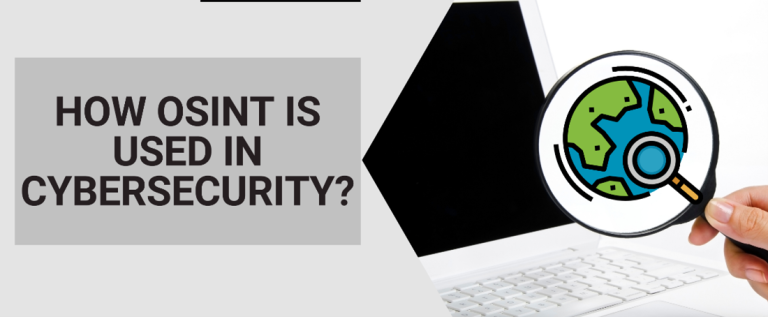Introduction:
In today’s digital environment, organisations must constantly fight to secure their systems and data from ever-changing cyber threats. A complete cybersecurity plan must include vulnerability assessment and penetration testing (VAPT). Open Source Intelligence (OSINT) frameworks and methodologies are critical for acquiring information and identifying possible vulnerabilities. In this blog article, we will look at how OSINT may help VAPT be more successful and give actionable information for safeguarding organisational assets.

Gathering Information:
Comprehensive information collection is required for effective vulnerability assessment and penetration testing. OSINT frameworks provide a plethora of tools and resources for gathering data about the target organisation or system. OSINT offers a solid platform for future research and evaluation by identifying public-facing assets like as websites, subdomains, IP addresses, and network architecture, as well as unearthing historical data or leaked material.
OSINT technologies like reconnaissance frameworks and online scraping software automate the data collecting process, resulting in a more efficient and complete approach. Cybersecurity experts may acquire access to a wide number of data sources by exploiting these frameworks, including search engines, social media platforms, public databases, and specialized OSINT technologies. This allows them to collect material from many web platforms and provide thorough coverage, lowering the possibility of missing important facts.
Foot printing:
OSINT tactics go beyond simple information collection by aiding in footprinting, which is the process of acquiring information about a target’s web presence, technological stack, organisational structure, and staff data. This process enables penetration testers to comprehend the target environment, identify potential attack paths, and evaluate overall security posture.
Tools and approaches for analysing metadata, network information, WHOIS records, and other publicly available data are provided by OSINT frameworks. Cybersecurity specialists may acquire insights on the target’s digital footprint, system architecture, software versions, and even possible weak places in the organization’s structure by exploiting these resources. This understanding provides a good foundation for developing efficient penetration testing methodologies.

Identifying Vulnerabilities:
Identifying flaws: Identifying flaws in the target’s systems and software is a primary goal of vulnerability assessment and penetration testing. While standard vulnerability scanning technologies are essential, OSINT approaches improve the process by offering real-time access to information about developing threats and known flaws.
Penetration testers may remain up to speed on the newest vulnerabilities and attack methodologies by monitoring public vulnerability databases, security advisories, and industry forums. OSINT frameworks connect to various sources and automate the monitoring process, alerting testers to serious vulnerabilities that require quick attention. This information enables them to analyse possible hazards and prioritise their testing efforts in the relevant areas.
Social Engineering:
Social engineering is a potent method used by attackers to exploit human weaknesses. OSINT is critical in social engineering evaluations, allowing penetration testers to acquire information about the target organization’s personnel, their positions, social media accounts, and other publicly available information.
Penetration testers can learn about workers’ hobbies, activities, and possible security flaws by analysing publicly available information, like as social media postings, professional networking platforms, or personal blogs. This knowledge aids in the creation of convincing phishing emails, impersonation attacks, or other social engineering tactics customised to the target’s environment. Penetration testers may recreate real-world settings and improve the effectiveness of social engineering tests by using OSINT.
Exploiting Publicly Available Information:
Publicly available information can provide valuable insights for penetration testers. OSINT techniques enable testers to exploit this information, uncovering vulnerabilities or gaining unauthorized access to systems. By analyzing leaked passwords, public file repositories, or user-generated content, testers can discover weak passwords, reused credentials, or sensitive information inadvertently exposed by the target.
OSINT frameworks offer specialized tools and resources for extracting and analyzing this publicly available information efficiently. By incorporating these techniques into the testing process, cybersecurity professionals can identify potential entry points that might have otherwise been overlooked. This enhances the overall effectiveness of the penetration testing engagement.
Contextualizing Vulnerabilities:
Contextualizing Vulnerabilities: When analysing vulnerabilities, context is critical. OSINT approaches aid in contextualising vulnerabilities by giving extra information about the possible impact or relevance of the vulnerability to the target. Penetration testers may prioritise their efforts and focus on the most significant security flaws by matching OSINT data with discovered vulnerabilities.
OSINT data, for example, may disclose the target organization’s reliance on obsolete software versions, vulnerable setups, or misconfigured cloud services. This contextual knowledge allows testers to comprehend the possible ramifications of individual vulnerabilities and modify their testing procedures accordingly. Testers may give a more focused and effective evaluation by combining technical vulnerability screening with OSINT findings.
Social Media Intelligence:
Social media platforms serve as rich sources of information for OSINT analysis. Penetration testers can gather valuable intelligence about employee behaviors, relationships, and potential security weaknesses. This information can be used to simulate targeted attacks or gain unauthorized access to sensitive systems, exposing vulnerabilities that would otherwise go unnoticed.
OSINT frameworks provide specialized tools for social media intelligence, automating data collection and analysis. Testers can analyze employee profiles, public posts, interactions, and even geo-tagged information to gain insights into the target’s operations, potential weak points, or entry paths for exploitation. This OSINT-driven approach helps simulate real-world attack scenarios and uncover vulnerabilities from a different perspective.
Reporting and Documentation:
Reporting and documentation: A thorough and well-documented report is an important component of every VAPT engagement. OSINT results should be included in this process to give proof, describe the attack vectors employed, and provide corrective advice.
By combining OSINT data into the final report, cybersecurity experts provide the organisation with useful context and actionable insights. This provides a description of the OSINT sources used, the vulnerabilities detected, the possible effect, and mitigating advice. The report’s comprehensiveness improves the organization’s capacity to handle identified issues effectively.
Conclusion:
OSINT methodologies and techniques are critical in successful vulnerability assessment and penetration testing in the ever-changing field of cybersecurity. Cybersecurity experts may get important insights, uncover vulnerabilities, and simulate real-world attack scenarios by exploiting publicly available information. However, it is critical to approach OSINT in a responsible and ethical manner, while also respecting private rights and legal bounds. When used correctly, OSINT improves the efficacy of VAPT, allowing organisations to resolve security flaws and secure their important assets in advance.

